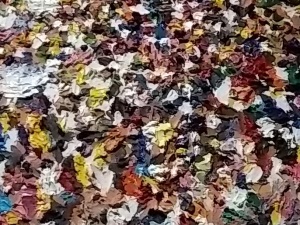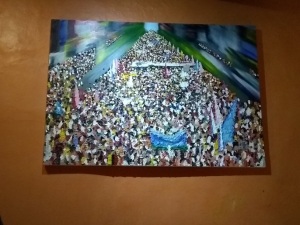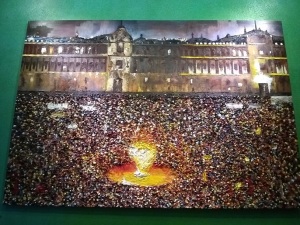I was at Lechón Illustrado recently looking at Samara Colina’s paintings with friend and artist, Catalina Gris. What I found most interesting was how the paintings worked on two levels. Up close, you could get lost in a fantastic abstract array of color patches.
Then, as you slowly move away, the image becomes more and more representational.
When the whole scene finally comes into focus, the sheer number of human figures represented is dizzying.
“Maybe,” I said to Cati, “maybe that’s what Kant meant by the mathematical sublime.” (Sidebar: I have more than once bantered my German friends that it takes a German like Kant to see mathematics as a sublime experience.) Anyway, Kant was talking about magnitude, but here it is literally a numeric overload; as you step back from the detail, the multitude is too great to fathom or even to be contained in the frame of the canvas. Even the spatula smears diagonally across the upper left and right warp the time-space curve into something larger than what the senses can grasp.
“No,” Cati said. “This isn’t it – the Kantian sublime.” Not that she didn’t like the painting, she just thought I was forcing in the theory. She was probably right. I always try a bit too hard to wrap my head around the mathematical sublime. (Kant’s power-based dynamical sublime is easier to grasp for me.)
“Maybe if the entire wall was covered,” Cati said.
“Yes,” I said, “That’s it.”
Whether representative of Kant’s mathematical sublime or not, it is a signature feature of Colina’s work (cp. the painting below, also at Lechón Illustrado).
(Click images below for links)








I don’t speak math, so much of the sublimity in the sciences escapes me. But in art, a language i get by in…
Done what you did with Rembrandt. Start far away—guards don’t like us walking backwards in galleries—so you see the portrait and walk towards it until you see the paint. To me, art should have evidence of the debate between form and content, which in good /sublime art ends in a draw.
LikeLiked by 1 person
Well-put on form and content, HJ!
LikeLike
Btw, HJ, never thought about guards and walking backwards. I probably have come sooo close to getting kicked out of sooo many museums.
LikeLike
Reading this, it occurs to me that we were both right, you had a sublime experience. Could be the paintings were hanging too high above my head to get the full effect, but enough to imagine being immerse in them… how ever, nice work.
LikeLiked by 1 person
Hahaha. Thanks for your generous comment, Cati. Not only are you conciliatory on the Kant thing, but you make me sound tall too!
LikeLike
It can’t be too bad a thing to have sublimity on your mind. Cheers,
LikeLiked by 1 person
true, bumba
LikeLiked by 1 person
Art is in the eye of the beholder, Kant or not. The first one, scrambled, appears like our lawn in Fall when the leaves have fallen and covered with abundant colors. Thanks for the post.
LikeLiked by 1 person
None of Kant’s utterances is ever easy for me to grasp! 🙂
LikeLiked by 1 person
Here is Kant trying to simplify it for you 🙂 :
“Now in the immensity of nature and in the insufficiency of our faculties to take in a standard proportionate to the aesthetical estimation of the magnitude of its realm, we find our own limitation, although at the same time in our rational faculty we find a different, non-sensuous standard, which has that infinity itself under it as a unity, in comparison with which everything in nature is small, and thus in our mind we find a superiority to nature even in its immensity.”
LikeLiked by 1 person
Thank you. Everything is clear as mud. 🙂
LikeLiked by 1 person
“The thought harmony of nature in the variety of its particular laws with our need of finding universality of principles for it, must be judged as contingent in respect of our insight, but yet at the same time as indispensable for the needs of our Understanding, and consequently as a purposiveness by which nature is harmonised with our design, which, however, has only knowledge for its aim.”
LikeLike
I like anyone who talks about the mathematical and the dynamic sublime.
LikeLiked by 1 person
Hahaha. You’ll love me then. At least for the first 5 minutes. Then you might find yourself wishing to change the subject 🙂
LikeLike